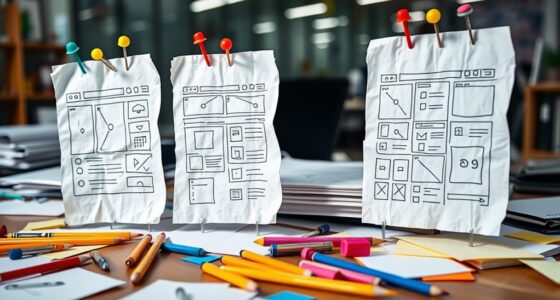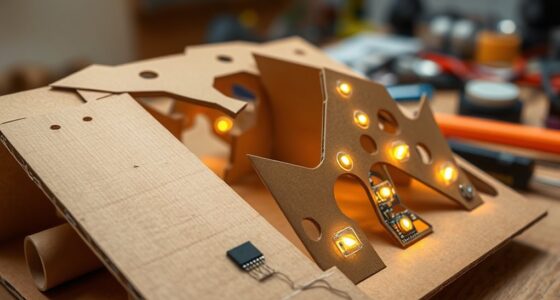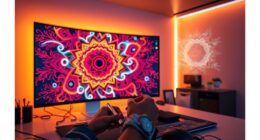When your concepts need precise visuals and clear communication, it’s time to upgrade from paper sketches to high-fidelity mockups. Signs include stalled stakeholder feedback, repeated design changes, or confusion about details. Moving to detailed prototypes helps clarify user flows and testing usability more effectively. If you’re aiming for development-ready designs and better collaboration, understanding when and how to shift can make all the difference—keep exploring to learn more.
Key Takeaways
- When stakeholder feedback becomes repetitive or unclear, upgrading to high-fidelity mockups clarifies design intent.
- If progress stalls or unresponsiveness increases, detailed mockups help move the project forward.
- Transition to high-fidelity visuals when accurate representation of interactions and branding is needed.
- Use detailed mockups to visualize complete user journeys and identify usability issues early.
- When testing and refining functionality, shift from sketches to interactive prototypes for better feedback.
When Your Concepts Need Precise Visuals
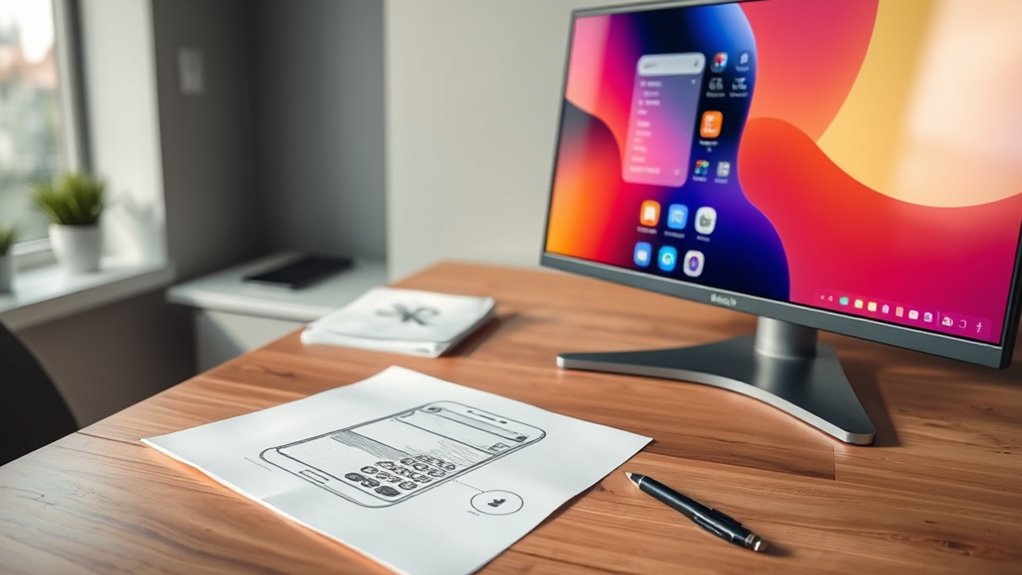
When your ideas require exact measurements and detailed representations, rough sketches just won’t cut it. You need tools that deliver visual precision to accurately communicate your concept. High-fidelity mockups allow you to showcase intricate details, precise dimensions, and realistic visuals that clarify your design intent. This level of accuracy enhances concept clarity, making it easier for stakeholders to understand your vision without ambiguity. Using scaled drawings ensures everyone is on the same page, reducing misunderstandings and revisions later. When precision is critical—such as in engineering, architecture, or product design—upgrading from rough sketches to detailed mockups becomes essential. You’ll find that this level of detail not only improves communication but also streamlines the development process, saving time and resources in the long run.
Signs That Stakeholder Feedback Is Stalled
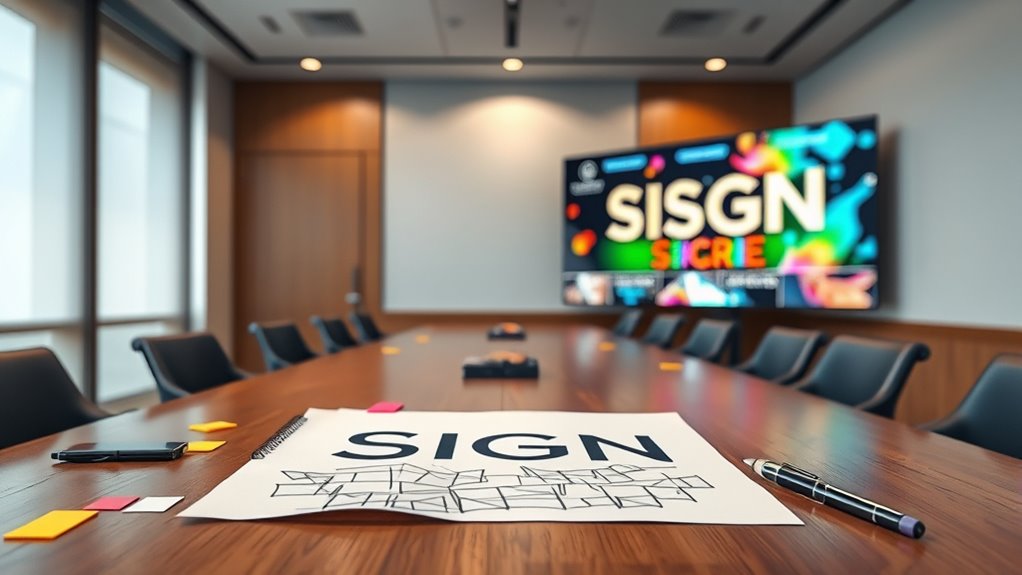
If you notice repeated requests for clarification, it’s a sign feedback isn’t moving forward. When decision makers become unresponsive, progress stalls, and the project loses momentum. Persistent design changes without resolution also indicate that stakeholder input isn’t being effectively integrated. Monitoring grocery savings strategies can help identify areas where stakeholder priorities might need realignment to keep the project on track.
Repeated Clarification Requests
Have you noticed repeated requests for clarification during stakeholder discussions? This often signals that feedback is stalled, and progress is hampered. When stakeholders keep asking for explanations, it indicates that the current mockups or sketches aren’t clear enough to guide decisions. During collaborative ideation, clarity is essential to maintain momentum and ensure everyone stays aligned. If clarification requests persist, it can threaten branding consistency, as divergent interpretations may develop. Upgrading from paper sketches to high-fidelity mockups can help eliminate confusion by providing more detailed visuals. Clear, precise mockups communicate your vision effectively, reducing repetitive questions and fostering smoother feedback cycles. Recognizing this sign early allows you to address misunderstandings promptly, keeping your project on track and stakeholders engaged. Additionally, applying resources and tools such as detailed mockups can significantly improve communication and help prevent misinterpretations.
Unresponsive Decision Makers
Persistent silence from decision makers during feedback sessions can signal that progress has stalled. When stakeholder engagement drops, it often indicates decision paralysis—you’re stuck waiting for input that isn’t coming. This silence hampers momentum, making it seem like the project has hit a standstill. You might notice decision makers avoiding discussions or providing vague responses, which signals that their confidence or clarity is waning. To break this deadlock, consider shifting your approach—ask targeted questions, provide clearer options, or set stricter deadlines. Recognizing that unresponsiveness isn’t a reflection of disinterest but often a sign that stakeholders need more guidance or reassurance. Addressing these cues early helps prevent further stalls and keeps your project moving forward. Additionally, understanding stakeholder behavior can be enhanced by observing their engagement with decision-making processes, allowing you to tailor your communication strategies effectively.
Persistent Design Changes
Noticing ongoing design revisions that seem excessive or unaligned with previous feedback can indicate that stakeholder input has stalled. When collaborative feedback becomes repetitive or no new ideas emerge, it suggests the team isn’t progressing through iterative refinement effectively. Instead of refining the design, you might find yourself cycling through similar changes, with little forward momentum. This stagnation often signals that stakeholders are unsure or disengaged, making further paper sketches less effective. Upgrading to high-fidelity mockups can help reignite the feedback loop by providing clearer visuals, enabling more precise critique and faster decision-making. Recognizing these persistent design changes as a sign of stalled input prompts you to shift to more detailed mockups, ensuring your project continues to evolve productively. Additionally, employing diverse design options such as different styles or materials can inspire fresh perspectives and break the cycle of stagnation.
Moving Beyond Basic Interaction to User Flows

To improve your designs, focus on visualizing complete journeys that show how users navigate your product. Enhancing interaction fidelity helps you understand and refine user experiences more accurately. Clarifying user intent guarantees your flows meet real needs and guide users smoothly through each step. Incorporating best vacuums for dust removal into your testing can also provide insights into how well your interface minimizes clutter and enhances usability.
Visualizing Complete Journeys
Moving beyond basic interaction, visualizing complete user journeys helps you understand how people navigate your product from start to finish. By mapping entire flows, you can identify pain points and opportunities for improvement. Incorporate storytelling techniques to create compelling narratives that illustrate user motivations and emotions at each stage. This approach guarantees your designs resonate with users and reinforce branding consistency throughout the experience. High-fidelity mockups make these journeys clearer, allowing teams to see how different elements work together seamlessly. When you visualize complete journeys, you move beyond isolated interactions, gaining a holistic view that informs better decision-making. Including contrast ratio considerations in your visualizations ensures that images display correctly across different lighting conditions and screen types, enhancing the overall user experience. This step is essential for aligning your design with user needs and building a cohesive, engaging experience from beginning to end.
Enhancing Interaction Fidelity
How can you make user interactions feel more natural and intuitive? By advancing beyond basic prototypes to incorporate virtual prototyping that captures interaction complexity. High-fidelity mockups enable you to simulate real user flows more accurately, revealing how users navigate and respond to different scenarios. This level of detail helps identify friction points and refine interaction design early, reducing costly revisions later. Incorporating realistic animations, transitions, and feedback in your prototypes makes interactions feel more genuine. As you move beyond static sketches, focus on creating seamless, fluid experiences that mirror actual app behavior. Enhanced interaction fidelity through virtual prototyping empowers you to test and iterate user flows effectively, ensuring your design feels intuitive and engaging before development begins. Additionally, consulting store hours information for relevant venues can assist in planning user testing sessions or stakeholder meetings efficiently.
Clarifying User Intent
Have you ever wondered if your prototypes truly capture what users intend to do? Moving beyond basic interactions, clarifying user intent requires understanding their goals through user flows. High-fidelity mockups help visualize these journeys, ensuring branding consistency and effective visual storytelling. When you focus on user flows, you identify gaps or ambiguities in the experience, which can lead to misinterpretation. Clear, detailed mockups allow stakeholders to see how users navigate tasks, making it easier to refine the design. This step minimizes assumptions, ensuring your design aligns with actual user needs and expectations. Additionally, understanding the types of cookies used on a website can improve the user experience by tailoring interactions and ensuring necessary functionalities are maintained. Ultimately, investing in high-fidelity representations enhances clarity, reduces misunderstandings, and creates a seamless experience that resonates with users and maintains your brand’s integrity.
When You Need to Test Usability More Effectively

When your initial usability tests reveal inconsistent results or unexpected user behaviors, it’s a clear sign that you need more targeted testing methods. High-fidelity mockups allow you to evaluate critical factors like color accuracy and branding consistency, which are essential for user trust and recognition. As users interact with more realistic visuals, you can better identify issues related to visual hierarchy, legibility, and overall aesthetic coherence. These detailed prototypes help uncover subtle usability flaws that paper sketches or wireframes might miss, ensuring the interface aligns with user expectations. Upgrading to high-fidelity mockups provides a more accurate environment to observe real-world interactions, making it easier to refine usability and deliver a seamless experience before moving into development.
Clarifying Design Details for Development Teams
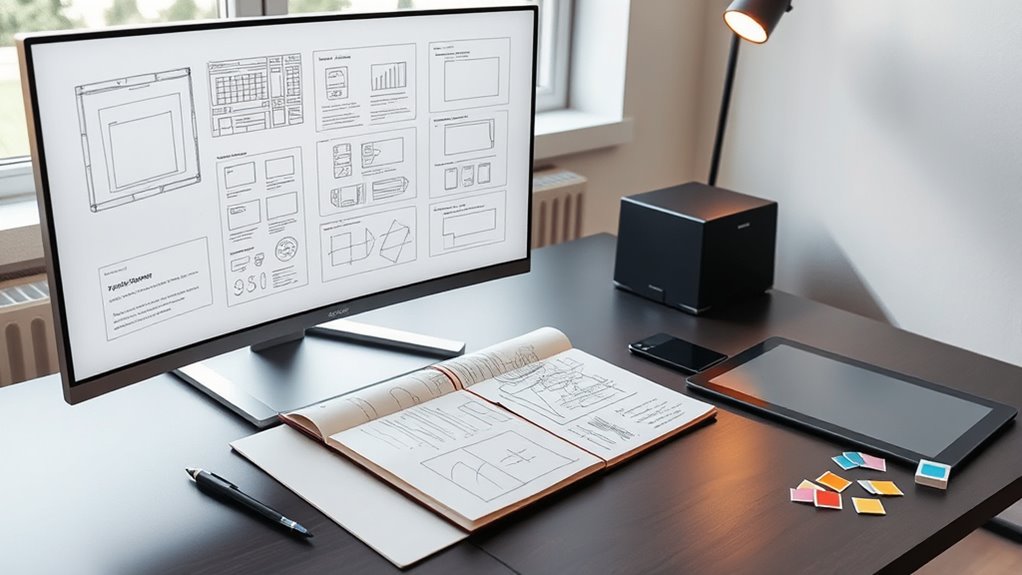
Are your design details clear enough for development teams to execute accurately? If not, it’s time to move beyond early concept sketches and engage in collaborative brainstorming sessions. These discussions help clarify nuances that sketches alone might miss, guaranteeing everyone shares a common understanding. Use high-fidelity mockups to specify precise layouts, interactions, and design elements, making sure nothing is left ambiguous. Clear documentation of design decisions, coupled with detailed annotations, reduces the risk of misinterpretation during development. When teams are aligned from the start, you minimize revisions later. Upgrading your mockups facilitates better communication, speeds up implementation, and guarantees the final product reflects your vision accurately. It’s an essential step to bridge the gap between design intent and development accuracy. Incorporating interior design basics principles into your mockups can further enhance clarity and effectiveness.
Scaling Up Your Prototype for User Testing
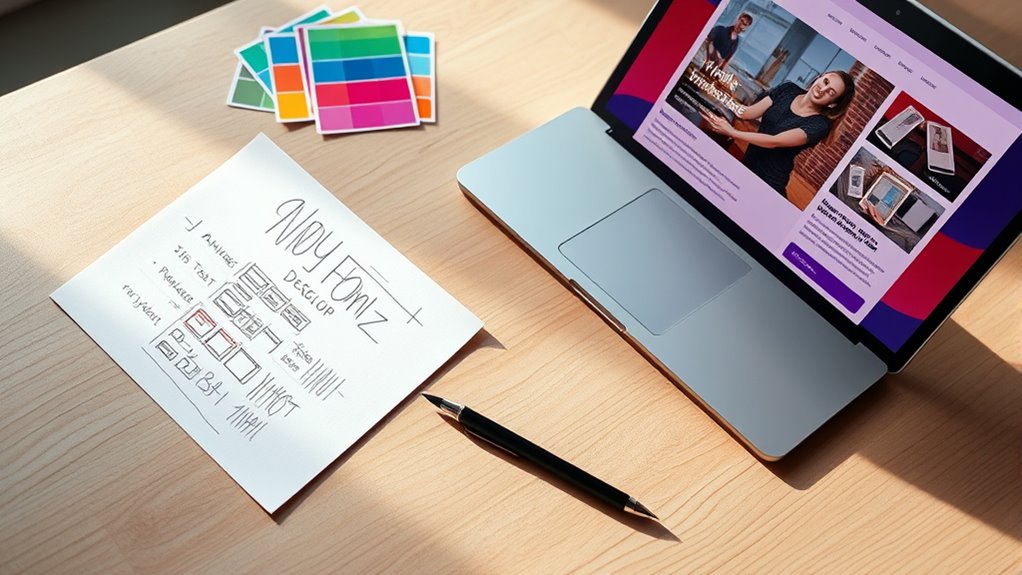
Once your design details are clearly documented and aligned with the development team, the next step is to scale up your prototype for user testing. Start by transforming your paper sketches into more detailed, interactive versions that better resemble the final product. This process allows you to test functionality and gather meaningful feedback. Rely on your quick ideation from earlier stages to refine interactions and layout before investing in high-fidelity mockups. You don’t need perfect precision yet—focus on usability and flow. Use simple tools like wireframing software or clickable prototypes to simulate user interactions. Scaling up at this stage helps identify potential issues early, saving time and effort later. It’s a critical phase to validate your ideas before moving toward polished, high-fidelity designs.
Frequently Asked Questions
How Do I Determine the Right Time to Transition From Sketches to High-Fidelity Prototypes?
You should shift from sketches to high-fidelity prototypes when you notice your design needs better visual consistency and more realistic user engagement. If your concept is clear enough to test user interactions and gather feedback effectively, it’s time to upgrade. High-fidelity mockups help you refine details, improve user experience, and guarantee your final product aligns with your vision, making it the right step forward.
What Tools Are Best Suited for Creating High-Fidelity Mockups Efficiently?
You might worry that creating high-fidelity mockups takes too much time, but with the right tools, it’s efficient. Use design software like Figma or Adobe XD, which streamline the process and support collaboration. These tools allow you to quickly develop detailed prototypes, gather feedback, and make adjustments in real-time. They’re perfect for turning your initial ideas into polished visuals without sacrificing speed or teamwork.
How Can High-Fidelity Prototypes Improve Stakeholder Buy-In?
High-fidelity prototypes boost stakeholder engagement by offering realistic visual storytelling, making your ideas clearer and more compelling. When you present detailed, interactive mockups, stakeholders can better understand the user experience and design intent. This transparency builds confidence, encourages feedback, and fosters buy-in. You turn abstract concepts into tangible visuals, ensuring everyone’s aligned and invested in the project’s success, ultimately streamlining decision-making and reducing misunderstandings.
What Are Common Challenges When Scaling Prototypes for Extensive User Testing?
When scaling prototypes for extensive user testing, you often face challenges like managing varied user feedback, which can complicate improvements. Higher prototype fidelity requires more resources and time, making iterations slower. You may struggle to balance detailed features with overall usability, risking overwhelming users or missing key insights. To succeed, you need to streamline feedback collection, prioritize core functionalities, and guarantee your prototype remains manageable for thorough testing.
How Do I Balance Detail With Development Timelines in Mockup Creation?
Balancing detail with development timelines demands deliberate decision-making. Focus on facilitating flexible feedback through collaborative feedback sessions, which guide your iterative refinement process. Prioritize high-impact details that enhance user experience without overloading your schedule. Keep mockups manageable, making swift updates easier and more efficient. This approach helps you strike a smart balance, ensuring your mockups are detailed enough to inform development while respecting project deadlines.
Conclusion
Switching from paper sketches to high-fidelity mockups can substantially boost your project’s success. Did you know that teams using detailed prototypes see a 30% faster approval process? Upgrading your visuals helps clarify design details, gather better feedback, and streamline development. When your concepts demand precision and you want more reliable user insights, it’s time to move beyond paper. Embrace high-fidelity mockups to turn your ideas into impactful, user-ready products.



